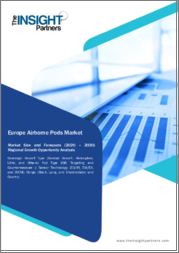
|
시장보고서
상품코드
1433967
세계의 항공 포드 시장 : 항공기 유형별, 포드 유형별, 센서 기술별, 재료 유형별, 최종 사용자별(2024-2032년)Airborne Pods Market - By Aircraft Type (Combat Aircraft, Helicopters, UAVs), By Pod Type (ISR, Targeting, Countermeasure), By Sensor Technology (EO/IR, EW/EA, IRCM), By Material Type (Composites, Metals), By End User, Forecast 2024 - 2032 |
||||||
항공 포드 시장 규모는 전 세계적으로 무인항공기(UAV)와 드론의 배치가 증가함에 따라 2024년부터 2032년까지 4% 이상 성장할 것으로 예상됩니다.
UAV는 군사, 국방 및 감시 활동에 필수적인 솔루션으로 부상하고 있으며, 무인 플랫폼에 향상된 기능을 탑재하기 위한 첨단 항공 포드에 대한 수요 증가에 기여하고 있습니다. 예를 들어, 2023년 2월 미국과 인도는 공동으로 공중 발사형 무인 항공기를 개발했습니다. 항공 포드는 첨단 센서, 카메라, 통신 시스템을 통합하여 무인 항공기의 기능을 확장하는 데 중요한 역할을 합니다. 감시, 정찰, 정보 수집에 이르는 무인기 임무 증가는 특수 항공 포드의 필요성을 촉진하고 산업 확장을 촉진하고 있습니다.
산업은 항공기 유형, 포드 유형, 센서 기술, 재료 유형, 최종 사용자, 지역으로 구분됩니다.
항공기 유형별로는 헬리콥터 부문의 항공 포드 산업이 2023년에 큰 수익을 창출하고 2024년부터 2032년까지 큰 견인력을 확보할 것으로 예측됩니다. 헬리콥터는 정찰, 감시, 조준 등 다양한 임무를 위해 항공 포드를 배치합니다. 포드의 다목적성은 헬리콥터의 작전 능력을 강화하는 데 도움이 되며, 특수 센서, 카메라, 통신 장비를 탑재할 수 있습니다. 군과 법 집행 기관이 현대화를 우선시하는 태도를 강화하는 것도 첨단 항공 포드에 대한 수요를 증가시키고 있습니다. 또한, 국경 경비대, 수색 및 구조, 대잠수함 전투에 헬리콥터 배치가 증가하면서 이 분야의 성장을 더욱 촉진하고 있습니다.
최종 사용자별로 보면, 군사 분야의 항공 포드 시장은 2024년부터 2032년까지 높은 수요가 예상됩니다. 이는 감시, 정찰 및 조준 능력을 강화하기 위해 군이 항공 포드에 대한 투자를 늘리고 있기 때문입니다. 항공 포드에는 첨단 센서, 카메라 및 통신 시스템이 탑재되어 방어 작전에 중요한 정보를 제공합니다. 현대전의 진화에 따라 군용기가 더 높은 정확도와 상황 인식으로 임무를 수행할 수 있도록 첨단 항공 포드에 대한 수요가 증가하고 있습니다. 또한, 국방 현대화와 위협 탐지에 대한 관심이 높아지면서 군사 분야에서 항공 포드의 배치가 더욱 확대될 것으로 보입니다.
지역별로 보면, 아시아태평양의 항공 포드 산업은 이 지역의 국방 예산과 현대화 노력 증가에 힘입어 2032년까지 6% 이상의 CAGR을 기록할 것으로 예측됩니다. 일부 APAC 국가들은 정찰, 감시 및 정보 수집을 위해 첨단 항공 포드를 통합하여 군사력을 강화하고 있습니다. 또한, 지정학적 긴장과 견고한 방어 시스템에 대한 수요 증가는 첨단 항공 포드 기술의 채택에 기여하고 지역 내 산업 확장에 박차를 가하고 있습니다. 예를 들어, 미국은 2023년 12월 인도의 억지력 유지와 국방 현대화 계획 강화를 지원하기 위해 인도 태평양 지역 파트너들에게 최첨단 군사 자산을 제공했습니다.
목차
제1장 조사 방법과 조사 범위
제2장 주요 요약
제3장 항공 포드 업계 인사이트
- 생태계 분석
- 공급업체 상황
- 원재료 공급업체
- 소프트웨어 개발자
- 제조업체
- 시스템 인테그레이터
- 최종사용자
- 비용 내역 분석
- 이익률 분석
- 기술 및 혁신 전망
- 특허 분석
- 애프터서비스 및 메인터넌스 분석
- 주요 뉴스와 이니셔티브
- 파트너십/협업
- 합병/인수
- 투자
- 제품 발매와 혁신
- 규제 상황
- 영향요인
- 성장 촉진요인
- 업계의 잠재적 리스크&과제
- 성장 가능성 분석
- Porter's Five Forces 분석
- PESTEL 분석
제4장 경쟁 구도
- 서론
- 기업별 시장 점유율
- 주요 시장 기업의 경쟁 분석
- Elbit Systems
- L3Harris Technologies
- Leonardo DRS
- Lockheed Martin
- Northrop Grumman
- Saab AB
- Thales Group
- 경쟁 포지셔닝 매트릭스
- 전략 전망 매트릭스
제5장 항공 포드 시장 추산·예측 : 항공기 유형별
- 주요 동향 : 항공기 유형별
- 전투기
- 헬리콥터
- UAV(무인항공기)
- 기타
제6장 항공 포드 시장 추산·예측 : 포드 유형별
- 주요 동향 : 포드 유형별
- ISR
- 타겟팅
- 카운터 메이저
제7장 항공 포드 시장 추산·예측 : 센서 기술별
- 주요 동향 : 센서 기술별
- EO/IR
- EW/EA
- IRCM
제8장 항공 포드 시장 추산·예측 : 소재 유형별
- 주요 동향 : 소재 유형별
- 복합재료
- 금속
제9장 항공 포드 시장 추정·예측 : 최종사용자별
- 주요 동향 : 최종사용자별
- 군
- 국토안보
제10장 항공 포드 시장 추산·예측 : 지역별
- 주요 동향 : 지역별
- 북미
- 미국
- 캐나다
- 유럽
- 영국
- 독일
- 프랑스
- 이탈리아
- 스페인
- 러시아
- 아시아태평양
- 중국
- 인도
- 일본
- 한국
- 동남아시아
- 라틴아메리카
- 사우디아라비아
- 남아프리카공화국
제11장 라비아 기업 개요
- Astronics Corporation
- Cobham plc
- CPI Aerostructures, Inc.
- Curtiss-Wright Corporation
- Elbit Systems Ltd.
- FLIR Systems, Inc.
- Israel Aerospace Industries Ltd.
- Kratos Defense & Security Solutions, Inc.
- L3Harris Technologies, Inc.
- Leonardo S.p.A.
- Lockheed Martin Corporation
- Northrop Grumman Corporation
- Podolsky International Corporation
- Rafael Advanced Defense Systems Ltd.
- Raytheon Technologies Corporation
- Saab AB
- Systima Technologies, Inc.
- Terma A/S
- Thales Group
- Ultra Electronics Holdings plc
Airborne Pods Market size is anticipated to expand at over 4% from 2024 to 2032 driven by the increasing deployment of unmanned aerial vehicles (UAVs) and drones across the world.
UAVs are emerging as integral solutions to military, defense, and surveillance operations, subsequently contributing to the rising demand for advanced airborne pods to equip unmanned platforms with enhanced capabilities. For instance, in February 2023, the U.S. and India collaborated to develop the air-launched unmanned aerial vehicle. Airborne pods play a crucial role in extending the functionalities of UAVs by integrating sophisticated sensors, cameras, and communication systems. The rise in unmanned aerial missions, spanning surveillance, reconnaissance, and intelligence gathering is fueling the need for specialized airborne pods, propelling the industry expansion.
The industry is segmented into aircraft type, pod type, sensor technology, material type, end-user, and region.
In terms of aircraft type, the airborne pods industry from the helicopters segment generated substantial revenue in 2023 and is projected to gain significant traction between 2024 and 2032. Helicopters deploy airborne pods for various missions, including reconnaissance, surveillance, and targeting. The versatility of pods helps to enhance the operational capabilities of helicopters, enabling them to carry specialized sensors, cameras, and communication equipment. The higher focus of military and law enforcement agencies on prioritizing modernization is also boosting the demand for advanced airborne pods. Additionally, the increasing deployment of helicopters in border patrol, search and rescue, as well as anti-submarine warfare will further drive the segment growth.
Based on end user, the airborne pods market from the military segment is anticipated to witness high demand from 2024 to 2032. This is owing to the increasing investments by military forces on airborne pods to enhance surveillance, reconnaissance, and targeting capabilities. Airborne pods are equipped with advanced sensors, cameras, and communication systems for providing critical intelligence for defense operations. With evolving modern warfare, the demand for sophisticated airborne pods is rising, enabling military aircraft to conduct missions with heightened precision and situational awareness. Additionally, the increasing focus on defense modernization and threat detection will further amplify the deployment of airborne pods within the military sector.
Regionally, the Asia Pacific airborne pods industry is projected to exhibit over 6% CAGR through 2032 fueled by the increasing defense budgets and modernization efforts in the region. Several APAC countries are enhancing their military capabilities by integrating advanced airborne pods for reconnaissance, surveillance, and intelligence gathering. Moreover, geopolitical tensions and the higher need for robust defense systems is contributing to the adoption of cutting-edge airborne pod technologies, adding to the regional industry expansion. For instance, in December 2023, the U.S. provided cutting-edge military assets to its partners in the Indo-Pacific to maintain deterrence and aid India in strengthening its defense modernization plans.
Table of Contents
Chapter 1 Methodology & Scope
- 1.1 Market scope & definition
- 1.2 Base estimates & calculations
- 1.3 Forecast calculation
- 1.4 Data sources
- 1.4.1 Primary
- 1.4.2 Secondary
- 1.4.2.1 Paid sources
- 1.4.2.2 Public sources
Chapter 2 Executive Summary
- 2.1 Airborne pods market 360 degree synopsis, 2018 - 2032
- 2.2 Business trends
- 2.2.1 Total Addressable Market (TAM), 2024 - 2032
- 2.3 Regional trends
- 2.4 Aircraft type trends
- 2.5 Pod type trends
- 2.6 Sensor technology trends
- 2.7 Material type trends
- 2.8 End-user trends
Chapter 3 Airborne Pods Industry Insights
- 3.1 Industry ecosystem analysis
- 3.2 Suppliers landscape
- 3.2.1 Raw material suppliers
- 3.2.2 Software developers
- 3.2.3 Manufacturer
- 3.2.4 System integrators
- 3.2.5 End Users
- 3.3 Cost breakdown analysis
- 3.4 Profit margin analysis
- 3.5 Technology & innovation landscape
- 3.6 Patent analysis
- 3.7 Analysis of aftermarket services and maintenance offerings
- 3.8 Key news and initiatives
- 3.8.1 Partnership/Collaboration
- 3.8.2 Merger/Acquisition
- 3.8.3 Investment
- 3.8.4 Product launch & innovation
- 3.9 Regulatory landscape
- 3.10 Impact forces
- 3.10.1 Growth drivers
- 3.10.1.1 Increased global defense spending to modernize military capabilities
- 3.10.1.2 Growing demand for Intelligence, Surveillance, and Reconnaissance (ISR) capabilities
- 3.10.1.3 Increasing advancements in sensor technologies, communication systems, and miniaturization
- 3.10.1.4 Increasing use of UAVs in military and civilian applications
- 3.10.2 Industry pitfalls & challenges
- 3.10.2.1 High development costs
- 3.10.2.2 Complexity in integrating airborne pods with existing aircraft or unmanned systems
- 3.10.1 Growth drivers
- 3.11 Growth potential analysis
- 3.12 Porter's analysis
- 3.13 PESTEL analysis
Chapter 4 Competitive Landscape, 2023
- 4.1 Introduction
- 4.2 Company market share, 2023
- 4.3 Competitive analysis of major market players, 2023
- 4.3.1 Elbit Systems
- 4.3.2 L3Harris Technologies
- 4.3.3 Leonardo DRS
- 4.3.4 Lockheed Martin
- 4.3.5 Northrop Grumman
- 4.3.6 Saab AB
- 4.3.7 Thales Group
- 4.4 Competitive positioning matrix, 2023
- 4.5 Strategic outlook matrix, 2023
Chapter 5 Airborne Pods Market Estimates & Forecast, By Aircraft Type (Revenue)
- 5.1 Key trends, by aircraft type
- 5.2 Combat aircraft
- 5.3 Helicopters
- 5.4 UAVs
- 5.5 Others
Chapter 6 Airborne Pods Market Estimates & Forecast, By Pod Type (Revenue)
- 6.1 Key trends, by pod type
- 6.2 ISR
- 6.3 Targeting
- 6.4 Countermeasure
Chapter 7 Airborne Pods Market Estimates & Forecast, By Sensor Technology (Revenue)
- 7.1 Key trends, by sensor technology
- 7.2 EO/IR
- 7.3 EW/EA
- 7.4 IRCM
Chapter 8 Airborne Pods Market Estimates & Forecast, By Material Type (Revenue)
- 8.1 Key trends, by material type
- 8.2 Composites
- 8.3 Metals
Chapter 9 Airborne Pods Market Estimates & Forecast, By End User (Revenue)
- 9.1 Key trends, by end-user
- 9.2 Military
- 9.3 Homeland security
Chapter 10 Airborne pods Market Estimates & Forecast, By Region (Revenue)
- 10.1 Key trends, by region
- 10.2 North America
- 10.2.1 U.S.
- 10.2.2 Canada
- 10.3 Europe
- 10.3.1 UK
- 10.3.2 Germany
- 10.3.3 France
- 10.3.4 Italy
- 10.3.5 Spain
- 10.3.6 Russia
- 10.4 Asia Pacific
- 10.4.1 China
- 10.4.2 India
- 10.4.3 Japan
- 10.4.4 Australia
- 10.4.5 South Korea
- 10.4.6 Southeast Asia
- 10.5 Latin America
- 10.5.1 Brazil
- 10.5.2 Mexico
- 10.5.3 Argentina
- 10.6 MEA
- 10.6.1 UAE
- 10.6.2 Saudi Arabia
- 10.6.3 South Africa
Chapter 11 Company Profiles
- 11.1 Astronics Corporation
- 11.2 Cobham plc
- 11.3 CPI Aerostructures, Inc.
- 11.4 Curtiss-Wright Corporation
- 11.5 Elbit Systems Ltd.
- 11.6 FLIR Systems, Inc.
- 11.7 Israel Aerospace Industries Ltd.
- 11.8 Kratos Defense & Security Solutions, Inc.
- 11.9 L3Harris Technologies, Inc.
- 11.10 Leonardo S.p.A.
- 11.11 Lockheed Martin Corporation
- 11.12 Northrop Grumman Corporation
- 11.13 Podolsky International Corporation
- 11.14 Rafael Advanced Defense Systems Ltd.
- 11.15 Raytheon Technologies Corporation
- 11.16 Saab AB
- 11.17 Systima Technologies, Inc.
- 11.18 Terma A/S
- 11.19 Thales Group
- 11.20 Ultra Electronics Holdings plc














